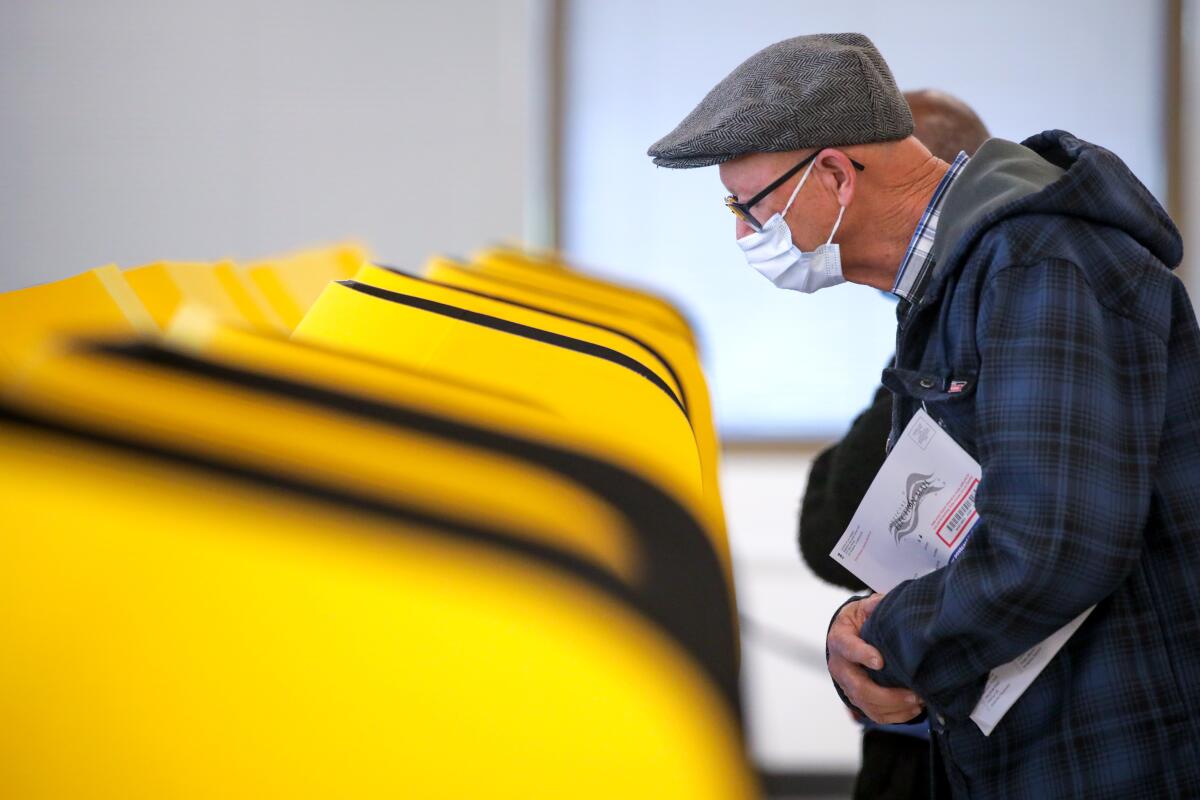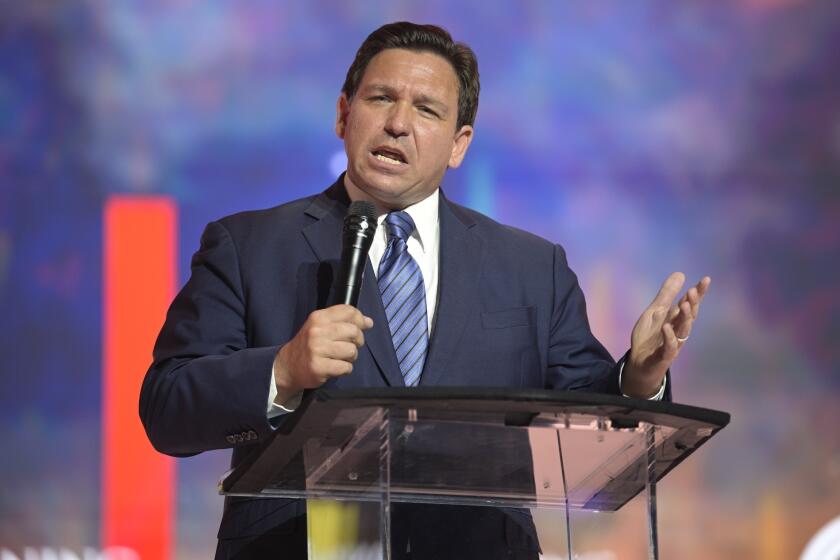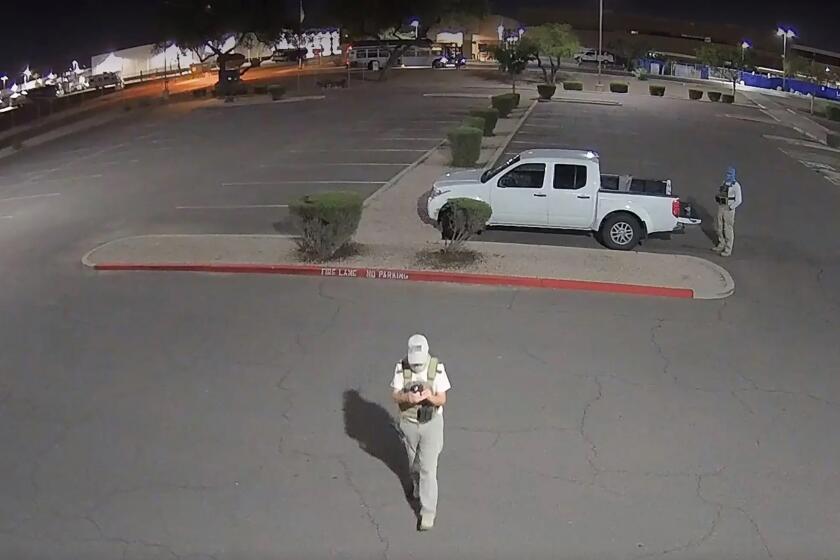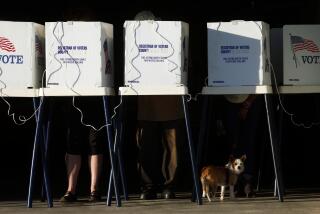Nearly 46 million votes have been cast in the midterms, but it’s unclear what it means for election day

Americans motivated by either anxiety, excitement or partisanship have turned out to early voting locations and returned mail ballots across the country, casting nearly 46 million votes as of Tuesday.
Turnout for the midterm vote — the halfway point of a president’s four-year term — is historically much lower than a presidential election year. In 2018, however, early turnout ran unusually high leading up to election day and a record midterm turnout. This year’s cycle appears to be following a similar trajectory.
The verve among voters leading up to Tuesday’s election highlights the changing landscape of American politics fueled by a pandemic that upended traditional voting methods and uncertainty about the state of democracy fed by former President Trump’s inaccurate claims of a stolen 2020 election.
In California, voting by mail has been popular among some groups, particularly older voters, for years.
The pandemic prompted several states in 2020 to implement universal ballot delivery or change their laws to allow for early voting or voting by mail for the first time, said Paul Gronke, a professor of political science and director of the Elections and Voting Information Center at Reed College in Portland, Ore.
Gronke anticipates America will see “substantially higher levels of early voting for at least the next few election cycles, if not permanently.” This also means results will likely be slower to roll out than many Americans expect, he said.
How does early voting work?
It depends on where you live. In 46 states and the District of Columbia, any qualified voter can cast their ballot ahead of election day. Some states send out ballots for voters to mail back and others set up locations so people can vote in person ahead of election day.
In 2021, California took steps to significantly expand vote by mail. The move was prompted, in part, by a large turnout of voters in 2020 when the state mailed ballots to more than 22 million people who were stuck at home because of the pandemic.
However, voters who prefer to visit the polls on election day can still do that.
Is a blue wave or a red wave coming on Nov. 8?
No one really knows and election experts are leery of drawing any conclusions.
With more voters casting their ballots early and more Democrats voting by mail, it may look as if there’s a Democratic surge in early results and perhaps for a few days after.
At the same time, many Republicans who in past elections sent their ballots by mail are now opting to vote in person. Much will depend on how they turn out on election day, experts say.
Basically, you can grab your surfboard, but we won’t know the hue of any wave for a while.
What can early voting tell us?
It’s one way to gauge interest in an election. Spoiler alert: people so far seem to be interested.
In California, it’s possible through public records to see the age and political party of everyone who has cast an early vote. As of late Monday, roughly 5.1 million mail-in ballots had been returned in California, according to election data reviewed by the consulting firm Political Data Intelligence.
About 51% were cast by Democrats, 28% by Republicans and 21% by independent voters or members of other parties.
Nearly half of the ballots cast were from voters who are at least 65 years old. Voters ages 50 to 64 cast 27% of the early ballots returned and those ages 35 to 49 made up 14%. The youngest block of voters ages 18 to 34 made up just 11% of the ballots cast so far, according to the tracker.
Texas pioneered this horror show before Florida joined, and the scare tactics work. They can discourage voters, spook donors and derail campaigns.
How do officials process mail-in ballots?
Generally, the first step is to compare the signature on the return envelope with the signature on record for the voter to confirm it matches. Workers in a secure room then flatten out the ballot so that it can be fed into a machine. But before that happens, the workers examine it to ensure there are no stray marks and the machines can read it.
The timing in which this process happens varies among states. Thirty-eight states, including California, permit election officials to begin processing— but not counting — the mail-in ballots before election day.
When will we know who won?
It depends on the race. The first set of results in California will be posted at about 8 p.m. on Tuesday, but in some races it could take days before a winner is declared.
In California, statewide races can take longer simply because of how many votes there are to count and because the state counts all ballots that are mailed by election day so long as they are received within the following week. Election officials have 30 days to complete the count and certify the results per state law.
The majority of states, including California, begin tallying the ballots to get results on election day before the polls close.
But 16 states and Washington, D.C., don’t allow workers to count mail-in ballots until all in-person voting has finished. Those states — Washington, Alaska, New Mexico, Idaho, Illinois, Minnesota, North Dakota, South Dakota, Alabama, Mississippi, Maine, Maryland, New Hampshire, Rhode Island, Vermont and Virginia — may see slower results because of that, election experts say.
Ten states — Arizona, Nevada, Utah, Hawaii, Colorado, Florida, Nebraska, Delaware, Kansas and Montana — permit workers to begin counting before election day.
“In states like Arizona, we’re likely to have pretty solid results on election night,” Gronke said, adding that in many other states that won’t be the case. “It’s going to make it particularly difficult this year with results coming in at different rates, and it’s going to open up a window for people to charge malfeasance.”
Still, he added, just because the vote is taking longer to count doesn’t mean there’s something wrong.
America has been through hard times before. But that’s little solace for voters worried about inflation, crime and abortion rights in this midterm election.
Is there anything I can do to figure out the results?
Probably not, unless you have visions of the future or a DeLorean that you’ve outfitted with a flux capacitor to make time travel possible.
If that’s the case, grab Doc Brown and let’s talk.
More to Read
Get the L.A. Times Politics newsletter
Deeply reported insights into legislation, politics and policy from Sacramento, Washington and beyond. In your inbox three times per week.
You may occasionally receive promotional content from the Los Angeles Times.












